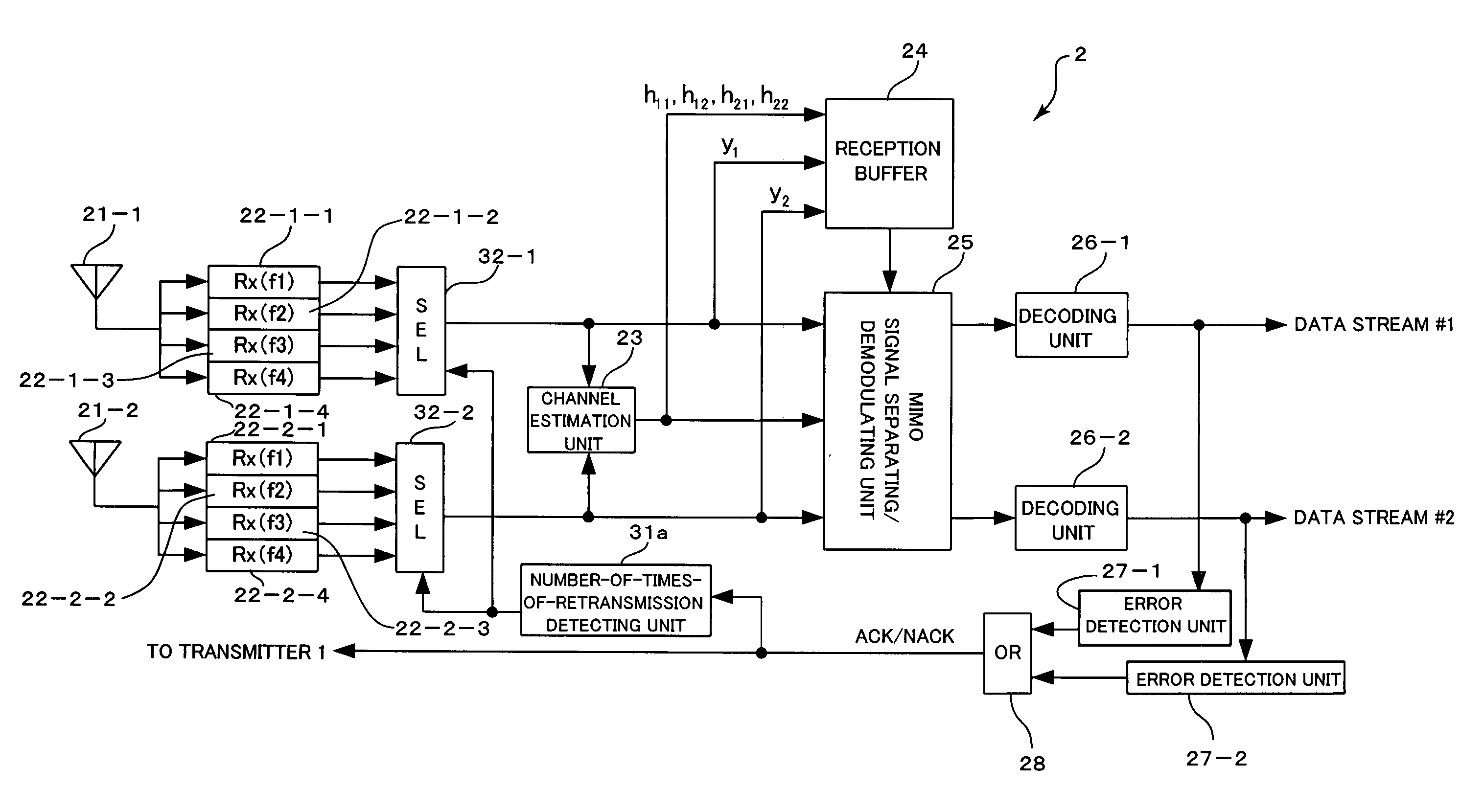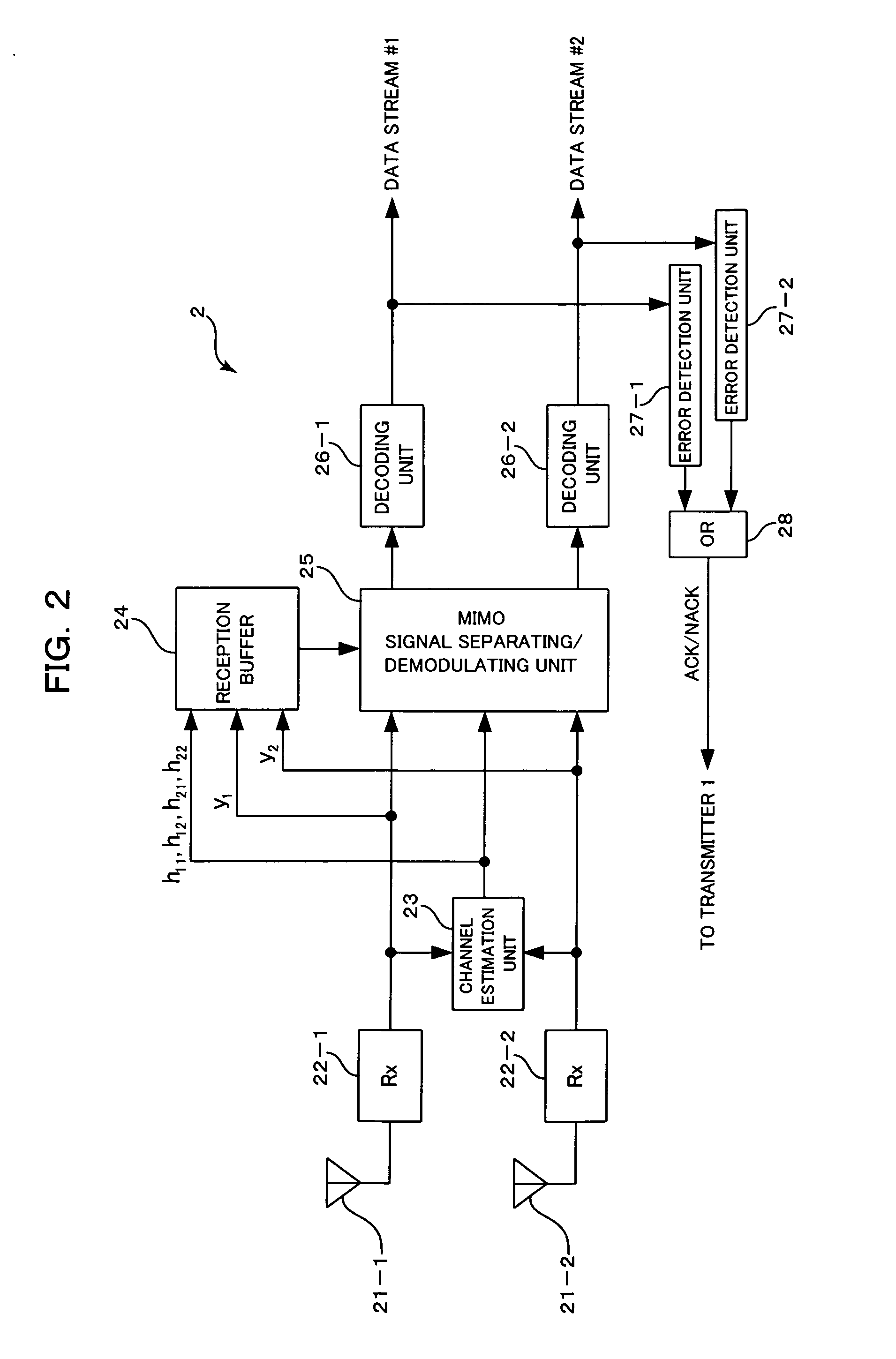Radio communication method and system, and receiver apparatus and transmitter apparatus
a radio communication system and receiver technology, applied in the field of radio communication systems, radio communication methods, receiver apparatuses and transmitter apparatuses, can solve the problems of significant degradation of demodulation characteristics, errors in demodulated data, and inability to perform signal separation well, so as to achieve sufficient characteristics improvement in retransmission combination, effective functioning of mimo signal separation
- Summary
- Abstract
- Description
- Claims
- Application Information
AI Technical Summary
Benefits of technology
Problems solved by technology
Method used
Image
Examples
first embodiment
[A] First Embodiment
[0080]FIG. 1 and FIG. 2 are block diagrams showing constructions of a MIMO transmitter and a MIMO receiver, respectively, constituting a MIMO communication system according to a first preferred embodiment of the present invention. The MIMO transmitter (transmitter apparatus) 1 of FIG. 1 is similar to the previous MIMO transmitter 100, which has already been described referring to FIG. 16. The MIMO transmitter 1 includes: two antennas 15-1 and 15-2; transmission buffers 11-1 and 11-2, encoding units 12-1 and 12-2, modulation units 13-1 and 13-2, and radio transmission units (Tx) 14-1 and 14-2, provided, one for each of the two transmitter antennas 15-1 and 15-2; and a retransmission control unit 16. The MIMO receiver (receiver apparatus) 2 of FIG. 2 includes: two receiver antennas 21-1 and 21-2; radio receiver units (Rx) 22-1 and 22-2, decoding units 26-1 and 26-2, and error detecting units 27-1 and 27-2, provided, one for each of the two receiver antennas 21-1 an...
second embodiment
[B] Second Embodiment
[0102]FIG. 4 and FIG. 5 are block diagrams showing constructions of a MIMO transmitter and a MIMO receiver, respectively, constituting a MIMO communication system according to a second preferred embodiment of the present invention. The construction shown in FIG. 1 differs from the transmitter 1 of FIG. 4 in that encoding units 12′-1 and 12′-2 in are provided in place of the encoding unit 12-1 and 12-2. The receiver 2 of FIG. 5 differs from the construction shown in FIG. 2 in that reception buffers 29-1 and 29-2 and combining units 30-1 and 30-2, one for each of the receiver antenna 21-i, are added between the MIMO signal separating and modulating unit 25 and the decoding unit 26-i, and that a number-of-times-of-retransmission detecting unit 31 is also added. In FIG. 4 and FIG. 5, the constituent elements which are given the reference characters already described are the same as or similar to the already described constituent elements unless otherwise described. ...
third embodiment
[C] Third Embodiment
[0120] Next, in the third and the fourth embodiment, a method for changing transmitter antennas at retransmission and a method for changing frequencies (carrier frequencies) at the time of retransmission are suggested in order to cope with characteristics deterioration when the fading correlation of the retransmission signal is high, such as in a case where retransmission interval is short in comparison with fading variation. With this method, even when correlation at the time of retransmission does not become low only with fading variation, correlation of the retransmission signal can be decreased, so that sufficient diversity gain can be obtained in combination before MIMO signal separation.
[0121]FIG. 7 is a block diagram showing a construction of a MIMO transmitter constituting a MIMO communication system according to a third preferred embodiment of the present invention. The transmitter 1 of FIG. 7 differs from the construction of FIG. 1 in that four transmi...
PUM
 Login to View More
Login to View More Abstract
Description
Claims
Application Information
 Login to View More
Login to View More - R&D
- Intellectual Property
- Life Sciences
- Materials
- Tech Scout
- Unparalleled Data Quality
- Higher Quality Content
- 60% Fewer Hallucinations
Browse by: Latest US Patents, China's latest patents, Technical Efficacy Thesaurus, Application Domain, Technology Topic, Popular Technical Reports.
© 2025 PatSnap. All rights reserved.Legal|Privacy policy|Modern Slavery Act Transparency Statement|Sitemap|About US| Contact US: help@patsnap.com



